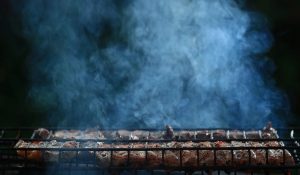Table of Contents
The unmistakable aroma of smoked meat can transport you to summer barbecues, rustic smokehouses, or quiet evenings spent experimenting in your own back garden.
Yet behind that rich flavour lies a surprisingly delicate process, and one of its most critical elements is often underestimated: the wood chips. Choosing the right type of wood, in the right quantity and condition, can elevate your smoking from decent to unforgettable.
Whether you’re a seasoned pitmaster or a curious home cook, understanding how smoke interacts with meat will help you achieve consistently excellent results, and it starts with the chips you burn.
Why Smoke Matters?

When wood burns slowly, it releases compounds that adhere to the surface of the meat, penetrating its fibres and infusing it with complex flavour. The main contributors to this profile are phenols, carbonyls, and organic acids.
Phenols are largely responsible for the smoky taste we associate with traditional barbecue, while carbonyls help develop that sought-after golden colour. Organic acids contribute a slight tanginess and act as natural preservatives.
This smoke-infused outer layer, or bark, forms over time and adds both texture and flavour contrast. But not all smoke is created equal, and not all wood chips behave the same way.
The differences between hardwoods and fruitwoods, their moisture content, and how they’re processed can influence everything from how fast they burn to the subtle notes they lend to meat.
Hardwoods vs. Fruitwoods: Knowing the Difference
Hardwoods, such as oak, hickory, and maple, are dense and burn for longer periods. They produce a robust smoke ideal for cuts that require extended cooking, like brisket or pork shoulder. These woods impart deep, earthy flavours and are often the go-to for traditional Southern-style barbecue.
On the other hand, fruitwoods like apple, cherry, and pear provide a lighter, sweeter smoke. They’re perfect for poultry, fish and seafood, and even certain vegetables. Applewood, for instance, creates a mildly sweet flavour that complements chicken and pork tenderloin without overpowering their natural taste.
Mixing the two types is also an option. For example, combining oak and cherry can balance strength and sweetness, but moderation is key. Too much of any one type can create bitterness or mask the meat’s true character.
How to Achieve Perfectly Smoked Meat with the Right Wood Chips?
Choosing the Right Wood for the Right Meat

Matching wood to meat isn’t a guessing game. It’s about harmony.
- Beef: Bold cuts benefit from strong flavours. Hickory and mesquite (in small amounts) work well. Oak is a reliable middle ground.
- Pork: A versatile protein that pairs with almost anything. Apple and cherry give it a pleasant fruitiness, while maple adds subtle depth.
- Poultry: Best kept light. Apple, pecan, and cherry work wonders without overpowering the meat’s delicacy.
- Fish: Needs a gentle touch. Alder and maple are popular, with minimal bitterness.
- Game meats: Consider juniper or walnut if available, but balance with milder woods to avoid harshness.
Don’t be afraid to experiment, but take notes as you go. Even small changes in wood blend or quantity can result in noticeable shifts in flavour.
Quality and Size of the Chips
The condition of your chips is just as important as their origin. Opt for untreated, food-grade wood, no varnish, glue, or chemical residues. When buying smoke chips in bulk, make sure the supplier guarantees quality and uniformity. Unevenly cut or overly dry chips can lead to inconsistent burning and flavour delivery.
Chip size matters too. Smaller chips ignite quickly and burn faster, which can be useful for shorter smokes or in electric smokers. Larger chunks, or wood chunks, are more suitable for charcoal smokers where longer burn time is needed.
Soaking chips in water is a common practice, though opinions differ. Soaked chips smoulder rather than flame, producing a steadier smoke stream, but too much moisture can delay ignition and reduce smoke intensity. In most home setups, a quick soak of 15–30 minutes is enough.
Avoid Common Mistakes

Many beginners assume more smoke equals more flavour. In reality, too much smoke can turn meat bitter and inedible. A thin, almost bluish smoke is ideal, not the thick white clouds you might associate with a dramatic BBQ scene.
Here are a few other common pitfalls to watch out for:
- Using green wood: Freshly cut wood contains too much moisture and releases acrid smoke.
- Neglecting airflow: Smoke needs to circulate. Poor ventilation leads to stagnant, heavy smoke and uneven cooking.
- Opening the smoker too often: Every time you lift the lid, you lose heat and smoke. Trust the process.
- Over-smoking: Especially with delicate meats, limit exposure. A couple of hours of smoke may be enough.
Smoking at Home or on a Professional Level
At home, success lies in consistency. Use a reliable thermometer, monitor internal meat temperature, and keep an eye on your chip tray. If you’re new to smoking, start with forgiving cuts like chicken thighs or pork ribs before progressing to brisket.
For professionals, maintaining flavour standards requires even more attention. Investing in high-quality wood chips wholesale is essential. Bulk orders from trusted suppliers, like https://doitathome.co.uk/en/247-smoking-chips-wholesale, ensure steady supply and uniform results. Having a variety of woods on hand also allows for custom blends tailored to client preferences or seasonal menus.
The Final Flavour Frontier
Mastering smoked meat is not just about technique or timing, it’s about understanding how every component contributes to the final flavour. Wood chips are more than fuel; they’re a crucial ingredient.
By learning which types enhance which meats, paying attention to chip size and quality, and avoiding basic errors, you give yourself the best chance at producing unforgettable results.
So next time you fire up your smoker, take a moment to consider your choice of wood. That seemingly small decision might just make the difference between a good meal and one your guests will talk about for weeks.


